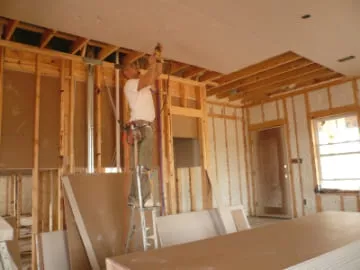Thanks for visiting our page onhanging drywall!
Hanging drywall is the first step in the process of drywall installation. This step includes the measuring and cutting of the drywall and the process of affixing the drywall to the studded wall surface.
These instructions are forwalls. We have created a separate set of instructions forhow to drywall ceilings, though the process is very similar.
One thing to keep in mind when following these instructions is that this is not theONLYway to hang drywall. Other books, websites, or sources of instruction may contain entirely different instructions for hanging drywall. From experience I can say that this is thesimplestandmost effectiveway that I have found.
Finally, drywallcanbe hung with nails. In fact, this is very common. We do not recommend using drywall nails. They are more difficult to use and far less effective than hanging drywall with screws. Our instructions below are for using drywall screws only.
If you haven’t already done so, check out theDrywall Preparationpage before beginning the drywall hanging process.
Necessary Materials for this Step
- Drywall
- Drywall Screws
Necessary Tools for this Step
- Tape Measure
- Pencil
- Razor Knife (with extra blades)
- Keyhole Saw
- Chalk Line
- Piece of Colored Chalk (to mark the location of outlet boxes)
- Electric Drill
- Dimpler Bit for Drill (optional but recommended)
- Drywall “T” Square
Drywall Hanging Instructions
Step One – Prework & Planning
The instructions on this page will assume that you are working with 4’ x 8’ drywall, the standard size for a sheet. If you are working with larger sheets, simply adjust your calculations where necessary.
If you are hanging drywall on both walls and the ceiling, you will want do hang drywall on the ceiling first, so that the drywall on the walls can assist in supporting the weight of the ceiling drywall. Use the separate instructions forceiling drywall.
Before beginning, you should cut power to the outlets and other electrical boxes that you will be drywalling around. Ensure that you have sufficient lighting to work. If necessary, run an extension cord with artificial lighting from another part of the house.
Next, go along and make a light pencil mark on the floor and ceiling indicating the placement of each of the vertical studs. These markers will assist you later on when you are ready to drive screws and attach the drywall to the studs.
Hanging drywall is typically a two-person job. Some parts can be done by a lone individual, but in general there will be portions of the process when working alone will become difficult and dangerous. A partner (or at least a person you can call on for a temporary helping hand) is a must.
Decide, before you begin, whether you will be hanging drywall horizontally or vertically. Vertically is easier for one person to accomplish, but most professional drywall installers will hang drywall horizontally.
The instructions below are for hanging drywall horizontally, but the same general steps will be used in vertical installation.
Step Two – Hanging the Initial Piece
Begin in a convenient place, usually a corner. Depending on the size of your room, you will likely have to do minimal or no cutting on the first piece.
If hanging drywall horizontally, hang the piece on the top of the wall first. Place the piece against the wall, tightly against the corner of the studs and tightly pressed against the ceiling.
Keep in mind that all pieces of drywall should begin and end on a stud. You should never have a piece of drywall overhanging a stud, or two pieces of drywall meeting in the open spaces between studs. If your stud walls were properly constructed on 16″ centers, you should have very few problems with this.
You will definitely need an extra hand holding this sheet of drywall up on the wall while you attach it to the studs.
Drive several screws in on the ends and middle of the sheet to hold it in place. You can come back later and drive the remainder of the necessary screws.
Screws should be driven in far enough to “dimple” the surface of the drywall. It should not break through the paper. A drywall “dimple bit” is an easy and convenient way to drive these screws in without driving them too far and breaking the paper.
Step Three – Measuring and Cutting Drywall
Now that you have your initial piece of drywall hung, you will begin the process of measuring andcutting drywall. Measure out from the end of your first sheet of drywall to the end of the wall.
If this is >8’, hang another full sheet. If not, measure out the distance from the end of the drywall. Then duplicate that measurement on your next piece of drywall. Mark the measurement lightly with a pencil and a drywall square.
To cut drywall, score the surface (along the line you’ve marked) with a razor knife. You may need to go over the cut several times until you’ve scored a fairly deep cut in the face of the sheet.
Now, bend the sheet of drywall along the scored cut. It should “break” cleanly and evenly along the cut. Once you have bent the sheet back at a ninety degree angle, cut the paper on the back of the drywall with your razor knife.
Repeat this process as you move along the wall, skipping back and forth between step four and step three. Measure and cut, then hang, each individual piece.
An Aside – Outlets and Light Switches
Outlets and light switches can be tricky. The best way that I have found to mark the location of these obstacles is the use of colored chalk.
First, ensure that the power to your electrical boxes, switches, and outlets isoff. Don’t take chances with electricity.
Second, rub the piece of colored chalk liberally along the edges of the outlet box or switch box.
Third, place the piece of drywall up against the wall exactly where it will hang, pressing it firmly against the chalked outlet box. The chalk should leave a visible square of color on the back of drywall, showing you where to cut out the piece.
Another Helpful Tip– Many home improvement stores also sell markers which you can purchase (usually for under $10) to help in the reliable marking of outlets and switch boxes.
Step Four – Hanging Drywall
Proceed by hanging the top pieces on your initial wall. Be sure that the factory edge is pressed tightly up against the ceiling. Leaving a gap of any sort will only make this more difficult to mud and tape later.
Following the instructions just above, cut out the holes for any outlets and switches before attaching the drywall to the studs.
You only need to drive enough screws into these initial pieces – five or six along the outer edges and three or four in the center – to hold the piece in place. You can come back to these at the end of the hanging process and insert the rest of the fasteners.
Hang the drywall directly over any windows or door openings. You can cut these openings out after the sheet has been attached.
When you place your next piece on the wall, be sure that your tapered edges butt against each other directly. The pieces should meet in the center of a stud, so that fasteners can attach each of the pieces directly to a stud.
Once you have attached all of your top pieces using a drywall saw or an electric rotary saw to cut around any openings such as doorways or windows. You should be sure to place all the necessary fasteners (screws) around the window or doorway before sawing to prevent excessive vibration or movement of the sheet.
Now you can proceed to the bottom pieces.
The standard height of a room is just over 8’, usually with about 1/2” of extra space. Standard drywall sheets are 4’ high. This will leave you with approximately 1/2” of gap. You want this gap to be on the bottom of the wall, where it will eventually be covered by baseboard trim.
When placing the bottom row of drywall, the seams on the drywall need to be staggered so that they do not line up with the seams on the top pieces. Often, this means that you must start the bottom of the wall with a half-piece or other partial piece of drywall.
Hang these in the same way that you hung the top pieces, cutting for outlets and switches before attaching to the wall. Cut out larger openings, such as doors and windows, after the drywall sheet it attached.
When hanging drywall, be doubly sure to leave any gap between the drywall and the floor, not between the top and bottom sheets of drywall.
Step Five – Fastening Drywall
Refer to the marks that you previously made on the floor and ceilings indicating the placement of the studs. Drive five or six evenly-spaced screws through the drywall and into the stud supports.
These screws should be spaced 7-9” apart on the studs, or every 4-5” apart around the circumference of any window or door openings.
Don’t screw directly into the edge of the drywall. Just as driving a nail into the edge of a board may split the wood, driving a screw too close to the edge of the drywall may cause the plaster to crumble. Place all screws approximately 3/8 – 1/2” in from the edge.
Before moving on to the taping and mudding steps, double check to ensure that all your screws are driven just below the surface of the drywall, creating a dimple in the paper.
If any of the screws have broken the surface of the paper, drive another screw to the correct depth just above or below it. Don’t sweat any mistakes that broke through the paper. These are easily covered up later on.
Congratulations! You have now completed hanging drywall! Now you are reading to move onto the next step in the drywall installation process.

